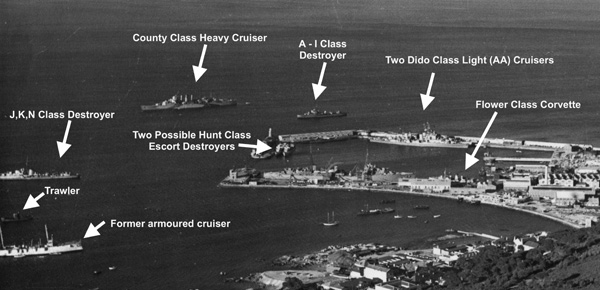A HARD FOUGHT SHIP
The
story of HMS Venomous
HMS Hecla:
Under repair at Simon's Town in South Africa
May - October 1942
The Mediteranean was an Axis lake and to join the the Far Eastern Fleet defending Singapore against the Japanese Hecla
had to head south and round the Cape of Good Hope. With Capt E.F.B. Law
RN in command she left Greenock on the 15 April 1942 as part of Convoy
WS.18 "outward bound" for South Africa. On the 15 May she rounded the Cape and as she crossed the Aghulhas Bank just east of
False Bay Hecla detonated a mine at 15.59 hours killing 21 of the crew (with 3
missing and 116 injured). Despite a huge gash in her starboard side Hecla
made her own way to the South African naval base of Simon's Town in
False Bay, the sheltered east side of the Cape, south of Cape Town. Find out more about mining of HMS Hecla and read the report of her CO Capt Law.
***************
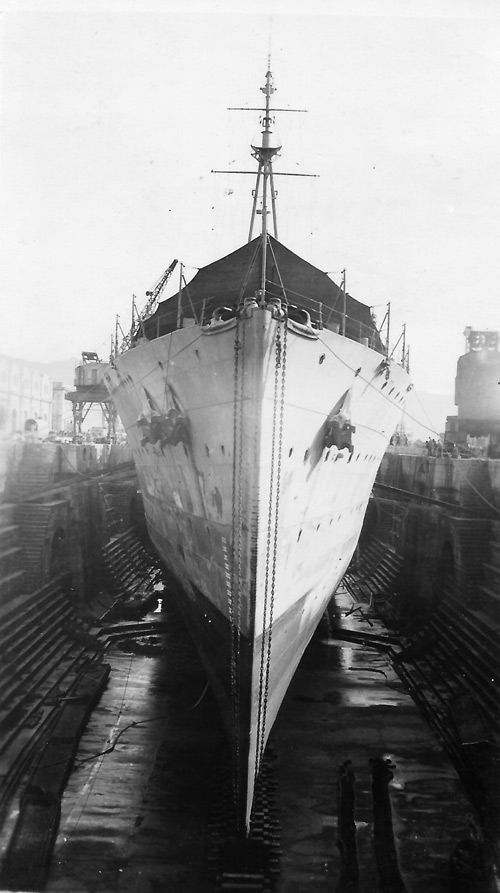
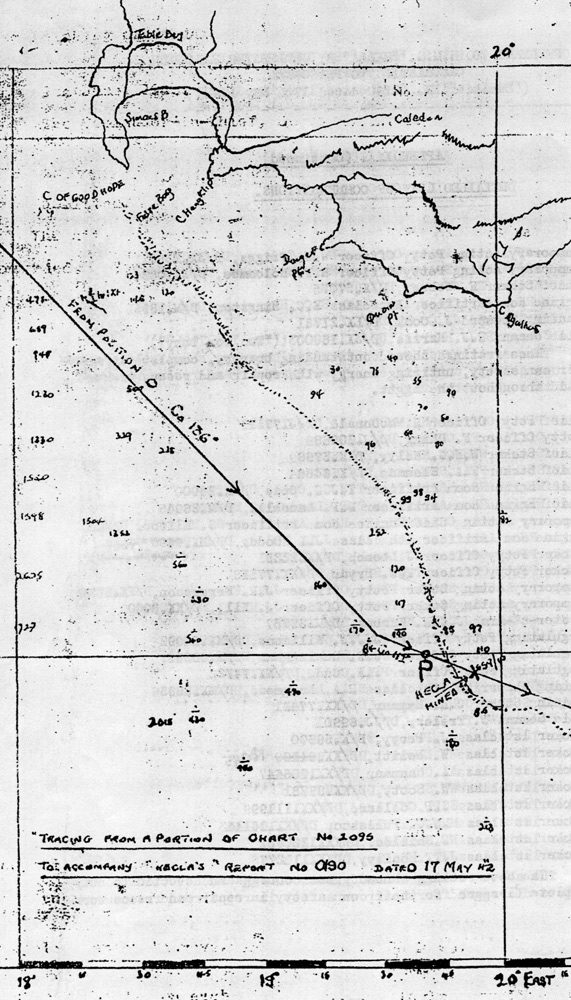 Lt Cdr Henry C.R. Alexander RN, the Navigating Officer on HMS Hecla, described the extent of the damage:
Lt Cdr Henry C.R. Alexander RN, the Navigating Officer on HMS Hecla, described the extent of the damage:
"I
anchored off the yard and divers were sent down to inspect the ship's
hull but their reports were inconclusive, so it was decided to dock the
ship immediately. When it was possible to walk under the hull in
gumboots we were greeted by a truly astonishing sight. The entire
ship's bottom from bilge keel to bilge keel over a length of some 150
feet had been lifted upwards to form a cupola resembling the dome of St
Paul's. The ships sides had held but every deck right up to the upper
deck was twisted and bent; it was not surprising that a five month
rebuild was forecast. The amazing thing was the efficiency of the
shoring, which had contained the 3000 tons of water we had taken in and
from a personal point of view I marvelled at my luck in having estimated
our speed so accurately and kept it down within safe limits."
Les Proctor, a rating in HMS Hecla, thought they were lucky not to have been sunk:
"HMS Shropshire was in dry dock but was immediately pulled and we went in at 16.30 hours. The Hecla
was 585 feet long and it was found that she had a hole 100 by 40 feet
with approximately 100 feet of keel missing. The keel loss would have
certainly made Hecla sink had
the engines been lost as the pressure of the propellers pushing forward
and the pressure on the hull pushing through the water somewhat
equalised so keeping the two halves together. In dry dock the two
sections were tied together to prevent the back breaking. After the two
halves were secured, we vacated the dry dock to Shropshire to allow her repairs to be finished."
PO Robert Reid ("Bob") Campbell, Ship's writer, took the photograph of HMS Hecla in the Selborne Graving Dock at Simon's Town sent to me by his son Neil Campbell. John Rodgaard, the author of "A Hard Fought Ship" identified the unnamed ship as Hecla by comparing it with other photographs of Hecla.
Common features included the three rows of port holes, the two anchors
on the starboard side, the tripod foremast and the platform, a
four-pronged crosstree between the two yardarms.
Charles Eastop and fifty of his colleagues on HMS Hecla left their ship at Simon's Town:-
“While
she was being repaired fifty or so of her communications staff,
wireless and signals, were sent to Mombasa to form a temporary staff
for C in C Eastern Fleet who was about to pull out of Ceylon and
establish a new base at Mombasa. The intention was for us to return to Hecla
on completion of repairs but we were never recalled and consequently
Admiralty not knowing the circumstances reported us all missing. Of
course we knew nothing of this until some weeks later when somehow the
news got thro’ to us and arrangements were made for each of us to send
news urgently to our families to say ‘we are safe and well’. It was a
great shock to us all to hear such sad news and know that we had lost
so many old shipmates – in fact I have never seen a complete list of
those who were lost.” Charles Eastop
Edward Coleman, an
Engine Room Artificer (ERA) in Hecla, described Simon's Town in his book Navy Days
(Andrew Books, 1999) as "quite a pleasing rural community, a few little shops, a small
cinema and a pub or two. The main street included a row of attractive
colonial style buildings more or less opposite the Dockyard. Admiralty
House stood fair and square at the end of the dockyard complex furthest
west from the main gate."
A "pub
or two" is an understatement as "there were no less than 18
'watering holes' in the couple of miles between the Drydock and the
Railway Station" (Bill Rice) Ted Coleman's book includes lots of gossip
about Simon's Town and an amusing description of Just Nuisance, a great Dane officially adopted by the Navy and owner of a regular bed in the Fleet Club in Cape Town. The crew "enjoyed all the advantages of a peace time visit to a
truly beautiful country plus the special welcome reserved for service
men by those South African whites who were on the whole still
sentimental about Britain and Royalty and keen to demonstrate that
loyalty" (Ted Coleman). Don Preece, Jabe Skelhorne
and Norman Holmes were amongst those whose final months were made the happier by the
generous hospitality they received in South Africa while on "up homers"
with hospitable South African families.
Two members of the Sick Bay team,
Brian Shaw and Ken Collings, stayed with Pet (Petrus) and Minnie
(Wilhelmina) Abrahamse on their farm at Hermon, ten miles north of
Wellington in
the Western Cape Winelands. Ken Collings survived but Brian Shaw was killed when Hecla
sank. Their daughter Cynthia le Roux kept the letters she received from them and their
families and her daughter, Louise Duncan, has sent me scans of this
correspondence. I have forwarded these to Ken Collings' son
Bruce Collings in New Zealand and to the only living relatives of Brian Shaw whose parents lived at Frodsham near
Warrington in Cheshire. These letters are a poignant reminder of
happier times. Read about their time on an "uphomer" with Cynthis le Roux on her parents farm at Hermon.
Hecla
was under repair in the Selborne Graving Dock at Simon's Town for three months
but did not leave South Africa until late October. She
was in dry-dock 16 May 1942 to 16 June 1942 and from 20 June 1942
to 18 August 1942 (details supplied by the Docking Master for the Naval
Dockyard, Simon's Town). The Naval Constructor who supervised repairs
at Simon's Town Dockyard throughout World War II was Thomas H Bentley
RCNC. He was supported by one or two "Home Agreement" draughtsmen from
the UK Dockyards and a number of Dutchmen who had managed to
escape from the Dutch East Indes just before the Japanese
invaded. The key artisans and supervisers
were seconded from the "Home Dockyards" in the UK and known as "Home Agreement Men"
but South African Railways and Harbours and the Mining Industry
produced a large number of top quality artisans and the Dockyard also
trained local men, artisans and clerks, both white and coloured, and
African labourers and riggers, usually Xhosa from Eastern Cape. Due to a shortage of blacksmiths, neded to bend main frames and shape plates for a big repair job such as Hecla, the Dockyard borrowed tradesmen from the S A Railways & Harbours Workshops in Salt River, Cape Town.
When HMS Hecla came out of drydock several young South Africans joined her crew. Gordon Nissen was barely 17 and Hecla was his first ship but "just before she sailed some of us were drafted to HMS Ceres a light C Class cruiser that was still under refit in Simon's Town". When Hecla
finally left Simon's Town in late October her crew thought she was returning to the UK but she
had secret instructions to head for Gibraltar and the invasion beaches
at Algiers for the North African landings, Operation Torch.
"We completed repairs to the
ship in mid October when we sailed to Saldhana Bay where we got
ourselves organised for future activities, the end of a pleasant
interlude. We went to Cape Town where our new Captain joined us. We
anchored off Simon's Town for some hours while we awaited our sailing
orders, which, to my surprise, meant going back up north through the
Atlantic. We arrived at Freetown on about the 6 November where we
stayed about three days while a convoy formed. We moved out into the
Atlantic and headed north.
We moved north with two destroyers, HMS Marne and Venomous, as escorts." PO Arthur Ching, Sick Berth Attendant
Her new CO, Capt George V.B. Faulkner RN,
was married to Celia Cloete, an Afrikaner name, another link with South
Africa. He had spent the previous two years at the Admiralty working
with the Director of Combined Operations. After Hecla sank he
distinguished himself while commanding the monitor HMS Abercrombie
by neutralising enemy resistance during the landings of American troops
in Sicily. He left the Royal Navy in 1947, moved to South Africa the following year and died
in Cape Town in 1962. One of his officers, Lt Herbert H. McWilliams SANF, an architect from Port Elizabeth, served as a 33 year old OD (Ordinary Seaman) on the lower deck of HMS Shropshire
before being sent for officer training. After service with Coastal
Forces at Lowestoft he was drafted to Simon's Town to join HMS Hecla. His paintings of Hecla sinking in London's Imperial War Museum are a fitting memorial to the men who died when Hecla was torpedoed on Armistice Day 1942.

Panoramic view of Simon's Town and False Bay on 6 October 1942
Several
copies of these two photograph are known to exist including a framed copy in
the Seven Seas Club in Simon's Town which is signed W Graham Woods,
presumably the photographer.
"Farthest to the left (West) is HMSAS Randfontein,
a converted whalecatcher. The rectangular object to her right is
the Battle Practice Target, which was towed by the Admiralty tug St Dogmael, seen to the right of Randfontein and astern of the hulk Thames. Just beyond the tug is the corvette HMS Rockrose which became the SAN Survey Ship HMSAS Protea after World War II. To her right is the stern of the Hulk Thames with the bow of HMSAS Oostewal beyond and beyond that the bow of the destroyer HMS Nizam. The cargo steamer anchored out in the Bay is Dolius, of Alfred Holt's Blue Funnel Line."
Nic Harrison provided the prints for scanning and use on this website
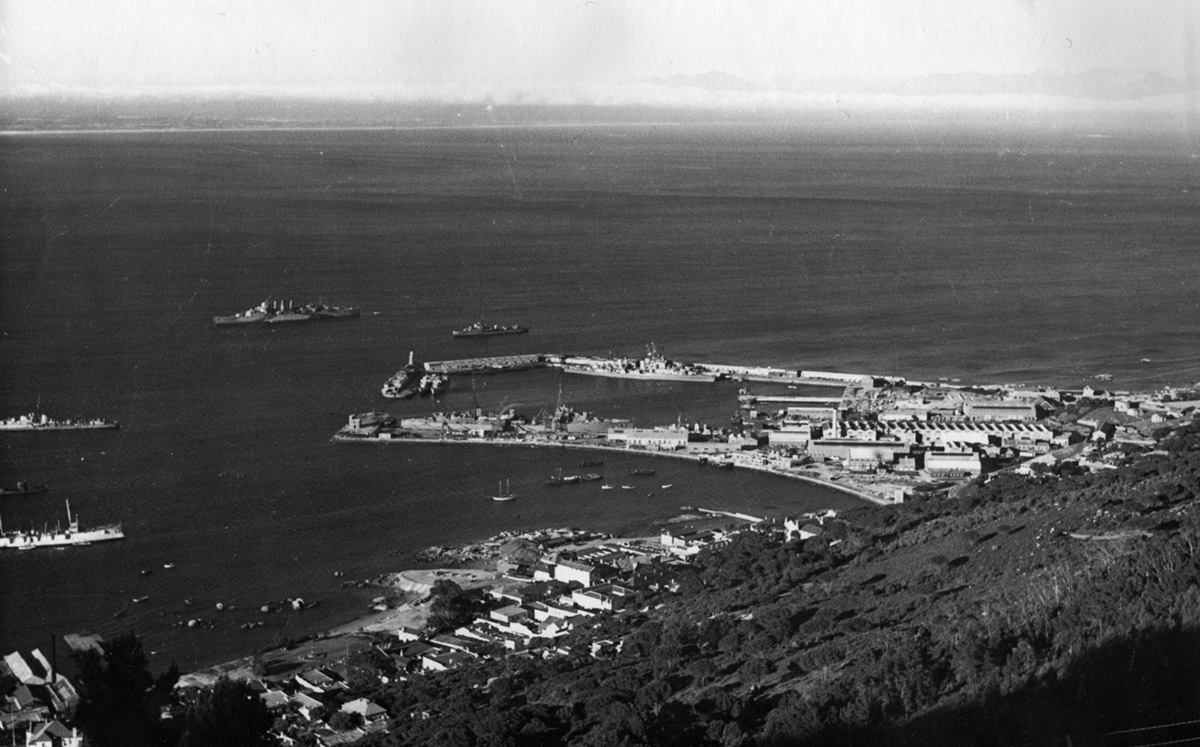 These photographs were taken from the hillside above Simon's Town on 6 October 1942 shortly before HMS Hecla and her escorts left for Freetown on their way to Gibraltar
These photographs were taken from the hillside above Simon's Town on 6 October 1942 shortly before HMS Hecla and her escorts left for Freetown on their way to Gibraltar
The annotation is by Capt John Rodgaard USN (Ret), author of A Hard Fought Ship: the story of HMS Venomous (2017)
HMS Hecla is berthed astern of the Flower Class corvette and is cropped out lower right to aid identification
Photographed by W Graham Woods
Several
copies of these two photograph are known to exist including a framed copy in
the Seven Seas Club in Simon's Town which is signed W Graham Woods,
presumably the photographer. Bill Rice, who served in the South
African Navy for 31 years and is a member of the club, has copied the
caption which identifies HMS Hecla and the other ships:
"Out in the Bay are, from left to right : the Admiralty hulk Thames (formerly the Training Ship General Botha and before that HMS Thames - light cruiser converted to a Submarine Depot Ship), the Destroyer HMS Nizam (partly obscured), HMS Shropshire and the destroyer HMS Foxhound.
Inside the Basin are, on the far side from left to right the Destroyers HMS Active and HMS Arrow, the Dutch Submarines HNeth MS 019 and K 14, and the Light Cruisers HMS Sirius and HMS Phoebe.
Most of the West Wall (in the foreground) is taken up by HMS Hecla and ahead of her are the Corvettes HMS Cyclamen and HMS Thyme. The Selborne Graving Dock is occupied by the Cruiser HMS Ceres and the Magnetric Loop layer HMS Mead."
There were twelve South African ratings in Hecla
when she left Simon's Town and four of them were amongst the 273 killed
or Missing Presumed Killed (MPK) out of the 858 officers and men in Hecla. Their names were extracted from the list compiled by TNT Data Services under contract to the Admiralty from the Pay and Victualing Records. The SA before the service number identifies them as
being South Africans serving in the Royal Naval Volunteer Reserve (SA) or the Seaward Defence Force (SDF). On
the 1st August 1942
the RNVR(SA) and the SDF were amalgamated to form the South African
Naval Forces (SANF). The proximity of service numbers beginning 330
suggests they trained together and would have known each other before
joining Hecla in October one month before she was torpedoed.
Bennett, John F Acting Engine Room Artificer 4th Class SA330351
Byrd, Alfred S Able Seaman SANF68677
Jones, Bernard Able Seaman SANF562630
Kirk, Harold A L Acting Engine Room Artificer 4th Class SA330284
Lloyd, George H Acting Engine Room Artificer 4th Class SA330353
Peers, Charles V Able Seaman SA562653
Ryder, Cecil E Writer SA330441
Sanders, Alwyn W Acting Shipwright 4th Class SA68491
Sjollander Allan T Acting Electrical Artificer 4th Class SA68251
Smith, Ian R Acting Electrical Artificer 4th Class SA68478
Smith, Warren E Ordinary Telegrapher SA330406
Ward, Edward J Acting Blacksmith 4th Class SA67496 / MX120155
Four of these ratings are on the official Admiralty list of men killed or MPK
and the Commonwealth War Graves Commission (CWGC) site which lists them
all as SANF and gives the additional details added here:
Bennett, John Frank SANF, Acting Engine Room Artificer 4th Class R.N.V.R. P/SA.330351, aged 23, son of Henry J. and Edith N. Bennett.
Lloyd, George Herbert SANF, Acting Engine Room Artificer 4th Class R.N.V.R. P/SA.330353, aged 32, son of George T. and Gertrude Lloyd, of Raynes Park, Surrey.
Peers, Charles
Victor SANF, Able Seaman V.562653, aged 26, son of Charles E.
Peers, and of Agnes M. E. Peers, of Mowbray, Cape Town, South Africa.
Smith, Ian Ronald
SANF, Electrical Artificer 4th Class. V.68478, aged 28, son of William
R. and Georgina I. Smith, of Uitenhage, Cape Province, South Africa.
Roger Smith, the son of Warren E. Smith,
Telegrapher, provided the details of his father's service in the Navy
on the linked page and I am hoping that the
families of some of the other men on this list will get in touch to tell their stories.
Can you provide further information about the time HMS Hecla and her officers and men spent in South Africa in 1942?
I would also like to acknowledge the assistance received from Simon's Town Museum, the South African Naval Museum, the members of the South African Naval Heritage Trust and Society plus Bill Rice, a volunteer at the Simon's Town Museum, and many other individuals.
Bill Forster
Holywell House Publishing

Torpedoed off North Africa!
HMS Hecla,
with Capt George Vivian Barnett Faulkner RN (1897-1962) as her new CO, was given secret orders
to support the Anglo-American invasion of North Africa, Operation Torch.
"In October 1942 Hecla
was deemed to be operational again. We left Simonstown and proceeded
about 100 miles north to Saldanha Bay where we 'hid out' for a week. On
the way into the Bay our navigator missed the boom entrance and took
the boom with us. We sailed back to Cape Town to provision and after a
brief stop over proceeded north en route to Gibraltar to participate,
as a destroyer repair ship in the North African landing." Les Proctor.
George Male thought Hecla
was only sixty percent seaworthy and they were heading back home for
further repairs and the crew stocked up with bananas, unobtainable in
England, during a brief stop over in Freetown. They left Freetown on
the 4 November as part of Convoy CF.7A bound for Liverpool and the last
known photographs of Hecla were taken by Tom Davis, a young rating on the destroyer escort, HMS Active.
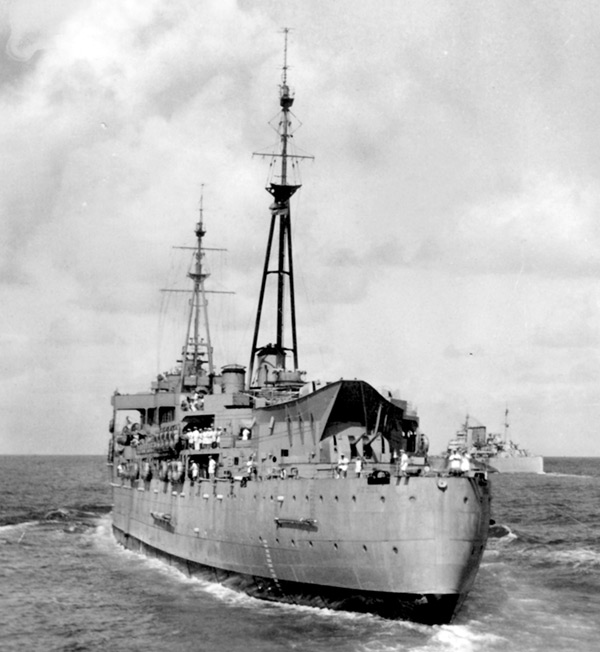
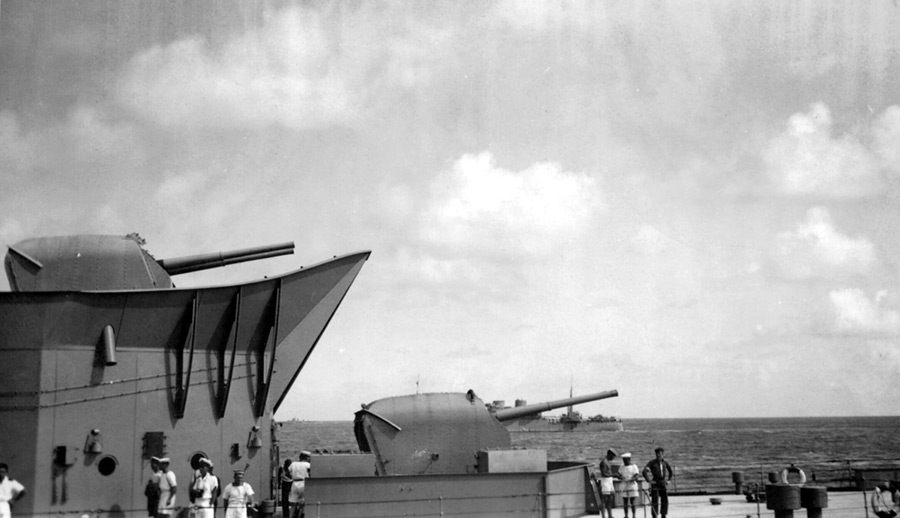
HMS Hecla left Freetown in west Africa as part of Convoy CF.7A and was photographed by Tom Davis. the ships writer on HMS Active
Courtesy of Steve Davis, the stepson of Tom Davis
The two destroyer depot ships, HMS Hecla and Vindictive, were joined by the destroyer escorts, HMS Venomous and HMS Marne,
near the Canaries on the 8 November and detached for Gibraltar to
support the ships taking the troops to the invasion beaches at Algiers as part of
Operation Torch.
At eleven minutes past
11pm on the 11 November 1942 the first torpedo hit Hecla ...
The story of HMS Venomous is told by Bob Moore and Captain John Rodgaard USN (Ret) in
A Hard Fought Ship
A Hard Fought Ship contains the most detailed account of the loss of HMS Hecla yet published
Buy the new hardback edition online for £35 post free in the UK
Take a look at the Contents Page and List of Illustrations
Return to the "Home Page" for HMS Hecla
to find out more about its history and the stories of other survivors
Holywell House Publishing
88 Holywell Hill, St Albans, Hertfordshire AL1 1DH, Britain
http://holywellhousepublishing.co.uk
Telephone: +44 1727 838595









 Lt Cdr Henry C.R. Alexander RN, the Navigating Officer on HMS Hecla, described the extent of the damage:
Lt Cdr Henry C.R. Alexander RN, the Navigating Officer on HMS Hecla, described the extent of the damage: 

